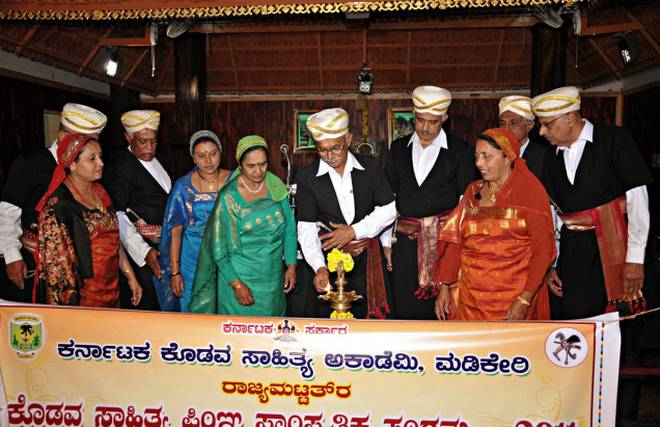
There was not much of an activity or even talk in public relating to preserving and nurturing the unique Kodava customs before the advent of the Karnataka Kodava Sahitya Academy in the early 1990s. Cultural observations essentially remained within the domains of the Kodava Samaja bodies or during the festivals and feasts. A new epoch had begun almost simultaneously with the coming into being of Kodava news weeklies. And, Kodava literary activities and cultural displays came into the limelight. Identifying those who had achieved laurels in various fields too began, thanks to the activities of the Academy, not just in Kodagu but also outside the district.
The two-day State-level Kodava Sahitya Samskritika Sangama (literary and cultural convention), held in Mysore here on March 1 and 2 was one such programme aimed at taking the Kodava culture to its people spread across the length ad breadth of the State and the country. It provided a platform for various speakers to give a clarion call for preserving and nurturing the Kodava culture for posterity.
The first day of the convention featured competitions involving different Kodava folk dances while on the second day selected speakers presented papers in a seminar with emphasis on arresting the trend of cultural degeneration. Speakers expressed concern at the erosion of Kodava culture and suggested various ways and means to stem the rot of Kodava language, literature and folklore. Traditional ‘Ummathat’ by women, and ‘Bolakkat’, ‘Kathiyat’, ‘Pareyakali’ and ‘Kolat’ by men stole the show.
Special drive
The president of the Mysore Kodava Samaja, Kattera A. Cariappa, observed that all-out efforts were needed to maintain the rich cultural practices of the Kodavas. There was a need to maintain unity among the members of the community. The president of the Karnataka Kodava Sahitya Academy, Rani Machaiah, said the Academy had embarked on a special drive to popularise ‘Kodavaism’ by taking up various programmes. The Academy had also invited three dance troupes from the Karnataka Janapada Academy — ‘Dollu Kunita’, ‘Pattada Kunita’ and ‘Puja Kunita’ — to perform as part of the exchange programme.
The Kodava Academy had organised programmes earlier in collaboration with the Karnataka Beary Academy and Karnataka Tulu Academy as part of the exchange programmes. This move was aimed at enhancing the camaraderie among the different communities. Ms. Machaiah, at the Mysore convention, expressed concern at the migration of Kodava people, particularly youth, from the district in search of greener pastures. Of late, many farmers had sold their land to move out of the district, she said, adding such a development could jeopardise the culture and growth of the Kodava language in Kodagu.
Efforts made by the Academy bodies in the past too are worthy of a mention here. For instance, the Academy took the learning of ‘Balopat’, the traditional folksong of the Kodavas, even to schools under the “Aat-Pat” (Dance and Song) programme. Cultural conventions across Kodagu have turned out to be crowd pullers.
Organising programmes in the rural parts of the district generated more awareness on the need to arrest the decline or dilution in Kodava culture.
Controversies
However, the Academy was not without controversies. Allegations of financial irregularities against certain office-bearers of the Academy had come as a slur on the fair name of the body. Moves to organise a World Kodava Conference in Madikeri had come to a naught as a result. There were controversies over the appointment of members to the Academy. Some were vociferous in demanding nominations to all Kodava-speaking groups and some were against it.
It happened that the political party in power on the day would have the final say in choosing the members to the Academy. At times, political party workers who owed allegiance to the party in power were comfortably accommodated.
A section of the Kodava-speaking groups felt that the Academy remained confined to organising cultural activities. There were more of displays relating to Kodava folk dances and cultural practices rather than literary activities, some still feel.
The talk that literary research works in Kodava should have come about, is also doing the rounds.
The efforts being made by the Kodava Elthkarada Koota, a body of Kodava writers, which had been bringing out books in Kodava every month, needs a mention here. Thanks to the advent of the Kodava weeklies, a number of budding Kodava writers have come to the fore.
This has indeed helped the spread of the Kodava language, though it has adopted the medium of Kannada for the script.
Jeevan Chinnappa
Vigorous efforts are on to preserve and nurture Kodava culture
source: http://www.thehindu.com / The Hindu / Home> Features> District Plus / by Jeevan Cariappa / March 12th, 2011

